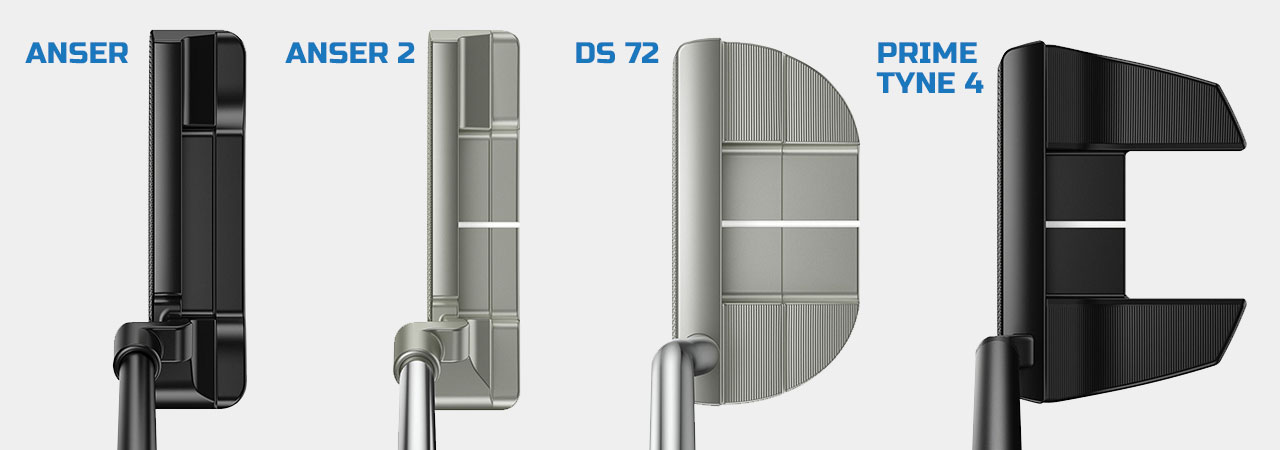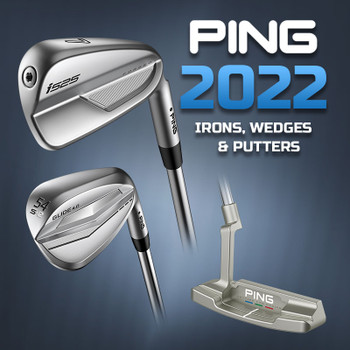PING i525 Irons, PING Glide 4.0 Wedges & PING PLD Putters
Posted by GolfBox on 9th Aug 2022
Every time PING release a new club, or three as is the case here, sure enough the same question arises for most golfers.
"When choosing clubs, do you base your decision on the proven metrics or buy into the hype?"
You see, PING are the masters at keeping it simple and selling the reality; preferring to let their clubs do the talking rather than relying on a hype-posse to convey the narrative. And that is why PING have for so long been regarded as the destination brand for golfers who rely on the plain and simple metrics to make their club selections.
If that sounds like you, PING’s NEW i525 irons, Glide 4.0 Wedges and PLD Putters are probably already on your radar. If not, you really should keep reading. All the way till the bottom.
PING i525 IRONS
Standing out in a player’s distance iron category that is as crowded as a public course on the weekend is a tough gig.
But when you understand what’s under the bonnet of the new hollow-bodied PING i525, in true PING style, the irons sell themselves.
PING i525 irons replace the i500 model and are faster and more consistent, thanks to a bevy of minor tweaks rather than a single “big sell” component.
SPEED THRILLS, FORGIVENESS RULES
To compete as a player’s distance iron, speed is an essential ingredient and PING have squeezed extra speed out of the i525 model via some additional face flex, without killing other attributes.
Borrowing a trick from the fairway wood playbook, the i525 face has been thinned out towards the edge while a revamp of the sole undercut provides additional support to allow the face to flex and rebound to a greater degree.
That is what makes the i525 faster and also more consistent, with off-centre strikes levelled out for a greater standardisation of speed and distance. Forgiveness has also been improved in the i525 irons, with MOI up by 2.5 per cent top-to-bottom and 3.5 per cent toe-to-heel in comparison to the previous i500 irons.
SMALLER YET SPICIER
The previous i500 was for some players too bulky, so the i525 ventures southward in both size and shape towards PING’s i210 player’s iron. The short irons in the i525 range are noticeably more compact, essentially replicating the blade length of the i210, while the long irons are larger but still smaller than their i500 counterparts.
But the toplines of all the i525 irons have been razored and the offset reduced, giving them more of a player’s-like appearance across the board.
HOLLOW-BODIED IRONS THAT DON’T OVERDO IT
The player’s distance category automatically lends itself to hollow-bodied tech, but PING aren’t one to overdo it. Rather than a cavity filled with any manner of polymer goop, PING’s i525 iron is filled with… air.
PING have taken this approach so the flex of the face won’t be impeded and kill ball speed. However, a small strip of polymer is affixed to the back of the face, which does more than enough to improve sound and quell vibration at impact.
i525 GROOVES
PING’s moisture-repelling Hydropearl finish features on i525 irons to maintain spin rates in any kind of weather but adding to the spin efficiency of the irons is a new MicroMax groove configuration.
The new grooves are squashed closer together to produce a more even spin performance, with fliers reduced in the short irons while the longer irons get more air time via optimised spin rates.
And in between the new MicroMax grooves is a textured milling called Friction Face, which further aids spin consistency when it’s wet, particularly in the short irons.
PING I525 IRON SPECS
- Hand: Right/Left
- Standard Shafts: Project X IO, UST Recoil ES 780 SMAC, PING Alta CB Slate
- Grip: Golf Pride MCC
- PING i525 Standard Iron Lofts: 3 (18°), 4 (21°), 5 (24°), 6 (27°), 7 (30.5°), 8 (35°), 9 (40°), PW (45°), UW (50°)
PING GLIDE 4.0 WEDGES
It’s been a busy time at PING HQ because the fourth edition of the Glide wedge is also ready to touch down. A wedge aimed at better players, the new Glide 4.0 wedges aren’t really revolutionary; more evolutionary and quite rightly, too.
The attributes that made the PING Glide wedge range so popular through the previous three iterations haven’t been undermined. Just refined and improved.
FACE VALUE
Most of PING’s attention has gone into designing a new face on the PING Glide 4.0 wedge. Each loft in the range has a unique groove design, with the lower-lofted wedges (50˚, 52˚) featuring a sharper groove sidewall and the higher lofts (54˚-60˚) receiving more of a sloping sidewall.
The sharper sidewall channels the grass and dirt more effectively out of the way at impact, improving spin on full shots, while the lower-gradient sidewall in the higher-lofted irons performs better for half shots and shots around the green and from the sand.
Also added to the face is a new rough texture finish, which provides extra grip, spin and control. Meanwhile, the Glide 4.0’s more rounded and compact head – crafted from 8620 carbon steel – has been coupled with a softer and larger elastomer insert at the rear.
The multi-material construction creates a soft and receptive feel off the face for precision feedback and control.
17 TO CHOOSE FROM
To service the complete range of players’-style requirements and performance, the Glide 4.0 line-up encompasses 17 different loft, bounce and grind options.
The four grinds (S, W, E, T) all feature a unique topography to take advantage of a player’s angle of attack and swing-type, maximising performance in all types of turf types and conditions.

- S Grind: An all-rounder grind, with relief out of the trail and leading edge, that should suit most golfers. Has a rounded leading edge paired with high bounce.
- W Grind: Traditional wide-sole grind that is extremely forgiving in soft turf conditions. With a rounded leading edge, it performs well for both full shots and open-faced bunker shots.
- E Grind: A revised take on PING’s famous Eye 2 L wedge, the high toe and scalloped sole make it a superb wedge out of the sand.
- T Grind: A half-moon sole grind and low bounce make the T Grind the perfect partner in firm turf conditions and from tight lies.
PING GLIDE 4.0 WEDGES SPECS
- Hand: Right/Left
- PING Glide 4.0 Wedge Loft/Bounce Combinations:
- S grind: 46°/12°, 50°/12°, 52°/12°, 54°/12°, 56°/12°, 58°/10°, 60°/10°
- W grind: 54°/14°, 56°/14°, 58°/14°, 60°/14°
- E grind: 54°/10°, 56°/10°, 58°/8°, 60°/8°
- T grind: 58°/6°, 60°/6°
PING PLD 2022 PUTTERS
PING’s tour-run PLD putter range is four strong in 2022, with the combination of premium materials and precision shaping sure to inspire on the greens.
And with the classic PING Anser and a couple of mallets in the mix, there should be something to suit everyone’s eye.
PLD FACE MILLING
Part of the attraction of the PLD putters is the premium roll off the face, which in the 2022 PLD line-up has been improved by an AMP. Sure, there are plenty of acronyms to get your head around but they pretty effectively convey what the PLD putter range is all about.
PLD stands for Putting Lab Design, a kind of Black Ops division of PING that custom builds putters for tour players. And AMP stands for Aggressive Milled Pattern, which is another way of saying pure roll off the face: a deep, diamond pattern is milled on to the face of every 2022 PLD putter for a soft feel and precise distance control.
THE FOUR PING PLD PUTTER MODELS
Forged from 303 stainless steel, there are four PING PLD 2022 putters to choose between:

- Anser: The original Anser blade, a renowned classic, returns in the PLD line-up. Finished in black and fitted with a graphite shaft, a plumber’s neck hosel provides a moderate toe hang that is suitable for slightly arcing strokes.
- Anser 2: Identical in shape and size to the Anser putter, the Anser 2 is finished in brushed chrome. A steel shaft and plumber’s neck hosel creates toe hang to suit strokes that open and close the face.
- DS 72: A revised version of the mid-mallet Viktor Hovland uses, the PLD DS 72 is face-balanced via a single bend shaft, which makes it the go-to putter for straight-back-and-through strokes.
- Prime Tyne 4: A mallet that has “fangs” protruding from its wings, the Prime Tyne 4 is geared for stability. A short slant neck hosel creates a moderate amount of toe hand to suit arcing strokes.
PING PLD PUTTER SPECS
- Hand: Right/Left
- Standard Lie Angle: 20˚
- Standard Loft: 3˚
- Standard grip: PP58 mid-size blackout
- PING PLD Toe Hang Putters: Anser, Anser 2, Prime Tyne 4
- PING PLD Face Balanced Putters: DS72
- Shafts: Anser: graphite stealth; Anser 2: steel chrome; DS 72: steel chrome; Prime Tyne 4: steel stealth
- Head Weights: Anser: 350g; Anser 2: 350g; DS 72: 365g; Prime Tyne 4: 360g

